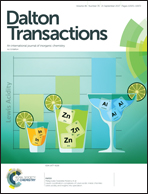Systematic size mediated trapping of anions of varied dimensionality within a dimeric capsular assembly of a flexible neutral bis-urea platform†
Abstract
A rationally designed ortho-phenylenediamine based trifluoromethyl meta-disubstituted bis-urea receptor (L) exhibits effective, consistent and systematic binding in its neutral form towards smaller spherical halides (fluoride, chloride, bromide and iodide), and relatively larger planar carbonate and tetrahedral sulphate oxyanions. All the complexes are well characterized both in the solid-state and solution phase. In the presence of excess fluoride anions, the receptor L encapsulates a hydrated cyclic fluoride-water [F2(H2O)2]2− tetramer inside the n-TBA cation sealed dimeric complementary cavity (complex 1). Whereas excess n-TBA/TEA salts of chloride, bromide and iodide result in unusual (Cl−)2, (Br−)2, and (I−)2 doubly encapsulated 2 : 2 dimeric host–guest complexes (2a, 2b, 3 and 4). Two receptor units encapsulate a carbonate ion, via hydroxide induced aerial CO2 fixation (complex 5), and a sulphate anion (complex 6), respectively, in the presence of excess tetrabutylammonium hydroxide and bisulphate salt. 1H NMR titration and 2D NOESY experiments corroborate the solution-state binding and encapsulation of hydrated/non-hydrated halides and oxyanions via N–H⋯A hydrogen bonding.



 Please wait while we load your content...
Please wait while we load your content...